Have you been caught with your mouth watering in front of the food displays outside of restaurants and then realized they were plastic? Well, you're not alone. Rumor has it a Japanese housewife once even picked up some model vegetables at the market and brought them home before finding they were not real.
Plastic food platters, often made of resin, are likened to "super models" in the restaurant and catering services industries and help attract diners who have bigger eyes than stomachs.
"I would say that half of my clients are attracted by the plastic food showcased in the window outside," said Hsu Lung-yuan (
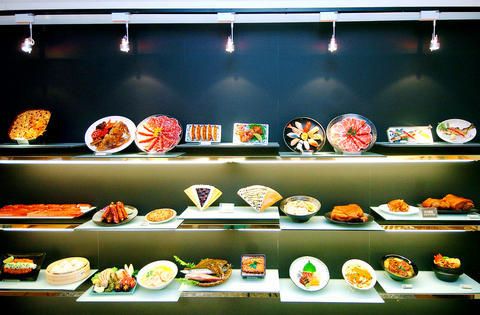
PHOTO: CHEN TSE-MING, TAIPEI TIMES
Hsu said the other half of his patronage at the Taipei shop comes in on word of mouth.
Hsu thinks the plastic food was a good investment -- at NT$3,000 (US$93) to NT$5,000 per bowl -- considering his restaurant opened only three months ago on Nan Chang Street (南昌街) and has already reached NT$7 million in revenue.
He said that plastic food is important and is becoming a part of the restaurant decor because it can "look so authentic it rouses the appetite."
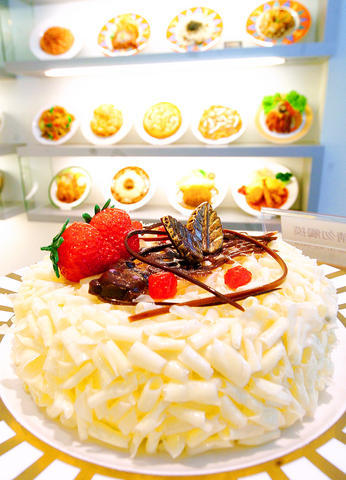
PHOTO: CHEN TSE-MING, TAIPEI TIMES
But, on the other hand, plastic food that is overdone or carelessly done can backfire and disgust customers who may feel ripped off if the food doesn't taste as good as it looks, said Hsu, who has been in the food service industry for more than two decades.
Hsu said that all the restaurants he has worked for take advantage of the so-called "three-dimensional menus" -- a marketing strategy that has been in place in Japan for more than seven decades.
To prepare for what Hsu call "pop-out menus," restaurants have to provide manufacturers with photos from many different angles and sometimes real dishes for silicone molding.
After that it takes anywhere from a few days to a full month to complete the pieces, depending on the manufacturer's schedule and the dish's level of complexity, said Oshiro Chiho, manager at Taiwan Saikyo International Co (
"More importantly, skilled hands make all the difference between turning out realistic pieces that rouse your appetite and those phony ones that upset it," Oshiro said, adding that her company spends almost five years to train a good hand.
The manufacturer still uses an apprentice program and has four skilled craftsmen on board.
Operating in Taiwan since 1997, Saikyo enjoyed the advantages of being one of the first movers in the market after setting up a factory in Shanghai in 1995.
Raw material and technology are directly imported from Japan while the products are manufactured in Shanghai and assembled in Taipei to meet the high standards demanded by its Taiwanese customers such as Azabusabo food chains (
"The secret to success is the ingredient formula, which allows us to create a fluid jelly-like texture for plastic food," Oshiro said, adding that is why the company does not compete with rivals on price.
Although the manufacturer said it can duplicate 98 percent of all food platters on a one-to-one scale, there are some limits.
If a food texture is too soft, such as Tanaka House's (田中家) chiffon cake, it may make it difficult for the restaurant to even make a silica gel mold to begin the process, Oshiro said. Coloring is another important skill that takes time to perfect.
Saikyo's business jumped 20 percent in 2003 -- one year before Taipei 101 was launched -- but has dropped 30 percent in recent years on a sluggish economy and with a major rival eating up market share, the manager said.
Saikyo is confident in the competitiveness of its own tailor-made products and, therefore, has refused to enter price competition with the rival, run by a former employee. The two take up the majority of market share in Taiwan.
Ex-Saikyo vice president Noriaki Nagaya jumped ship and started his own shop Taiwan Yenching Industry Co (
Despite being a latecomer, Yenching aims for bigger business in Taiwan.
As a former executive at rival Saikyo, Nagaya knows all about Saikyo's pricing and his company attempts to edge out its rival with cheaper prices in the local marketplace.
"I don't think the local market is oversaturated," he said. "It's all about how we tap into fields outside of meal samples, such as the bakery industry, to expand business."
Reaching "more than NT$10 million in annual sales," Yenching has further transformed itself into a food-sample exporter by supplying plastic cigars to a British company and meat bun models to an African company.
"We have sample orders from overseas markets such as Singapore, Hong Kong and the US, which account for about 10 percent of our sales," Nagaya said.
Nagaya sees no limit for what his firm can manufacture -- anything as small as a chocolate bean to as big as a smoked duck is fair game -- saying the company dares to take on the challenge of cabbage or chiffon cake models that rivals say are difficult to manufacture.
He said that his chocolate beans look so real that one of his friends only found the difference when he tried to chew one.
"Skills are the key," he said, adding that the company had successfully boosted its yield rate from 80 percent to 90 percent.
Sample food models originated in Osaka in 1932, the brainchild of Japanese businessman Iwasaki Luruzo, who began the industry's mass production, Nagaya said.
It has become not only part of Japan's food culture, but also part of its tourism business with some 170 stores lining a Tokyo tourist block selling nothing but plastic food sample-related gadgets such as key chains and flash memory drives.
After 70 years, the food sample industry in Japan might have shown signs of slowing down, but food samples continue to catch eyes.
"Very often, customers can't help but stop to take a look at the models before they decide what to eat," Nagaya said.
But what Nagaya doesn't deny is that, despite the industry's seven-decade history, it still has problems entering the doors of top-tier restaurants, where wealthy customers pay big money to be wined and dined.
"The moment you see plastic food models, you know you are either in a common food court or at a restaurant with value-priced foods," said Yeh Yi-lan (
Fancy restaurants, which seek innovations in either cooking or eating fashions, often find plastic samples a failure since no models, no matter how delicate they are, can truly convey their image to higher-end clientele, Yeh said.
To address this weakness, Nagaya said that his company is putting effort into beefing up its capabilities in "designs and novelty."
But before then, plastic food sample makers can only try to tap into different food sectors to expand business.
Still, Yeh is positive about plastic food models and says that most of the items on the market are getting more and more vivid.
"Not only do they stimulate the appetite, well-made plastic food can help people make decisions [about what to eat]," she said.
They are particularly helpful to foreigners who come to a new country without knowing anything about its food culture or dish contents, she said.
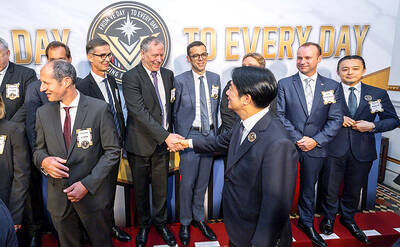
DEFENDING DEMOCRACY: Taiwan shares the same values as those that fought in WWII, and nations must unite to halt the expansion of a new authoritarian bloc, Lai said The government yesterday held a commemoration ceremony for Victory in Europe (V-E) Day, joining the rest of the world for the first time to mark the anniversary of the end of World War II in Europe. Taiwan honoring V-E Day signifies “our growing connections with the international community,” President William Lai (賴清德) said at a reception in Taipei on the 80th anniversary of V-E Day. One of the major lessons of World War II is that “authoritarianism and aggression lead only to slaughter, tragedy and greater inequality,” Lai said. Even more importantly, the war also taught people that “those who cherish peace cannot
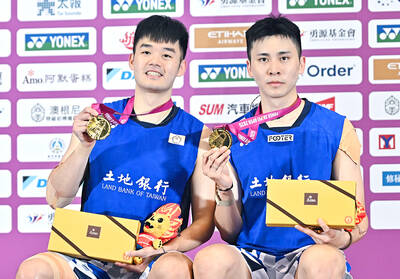
Taiwanese Olympic badminton men’s doubles gold medalist Wang Chi-lin (王齊麟) and his new partner, Chiu Hsiang-chieh (邱相榤), clinched the men’s doubles title at the Yonex Taipei Open yesterday, becoming the second Taiwanese team to win a title in the tournament. Ranked 19th in the world, the Taiwanese duo defeated Kang Min-hyuk and Ki Dong-ju of South Korea 21-18, 21-15 in a pulsating 43-minute final to clinch their first doubles title after teaming up last year. Wang, the men’s doubles gold medalist at the 2020 and 2024 Olympics, partnered with Chiu in August last year after the retirement of his teammate Lee Yang
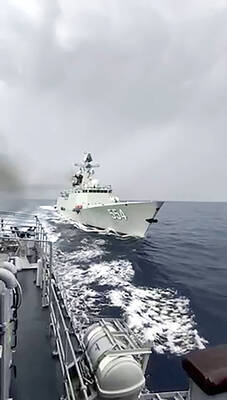
The Philippines yesterday criticized a “high-risk” maneuver by a Chinese vessel near the disputed Scarborough Shoal (Huangyan Island, 黃岩島) in a rare incident involving warships from the two navies. The Scarborough Shoal — a triangular chain of reefs and rocks in the contested South China Sea — has been a flash point between the countries since China seized it from the Philippines in 2012. Taiwan also claims the shoal. Monday’s encounter took place approximately 11.8 nautical miles (22km) southeast” of the Scarborough Shoal, the Philippine military said, during ongoing US-Philippine military exercises that Beijing has criticized as destabilizing. “The Chinese frigate BN 554 was
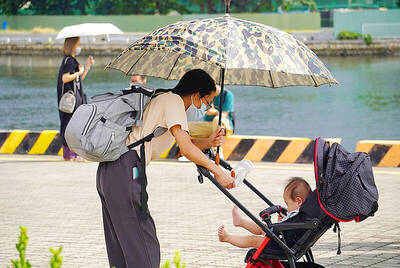
The number of births in Taiwan fell to an all-time monthly low last month, while the population declined for the 16th consecutive month, Ministry of the Interior data released on Friday showed. The number of newborns totaled 8,684, which is 704 births fewer than in March and the lowest monthly figure on record, the ministry said. That is equivalent to roughly one baby born every five minutes and an annual crude birthrate of 4.52 per 1,000 people, the ministry added. Meanwhile, 17,205 deaths were recorded, resulting in a natural population decrease of 8,521, the data showed. More people are also leaving Taiwan, with net